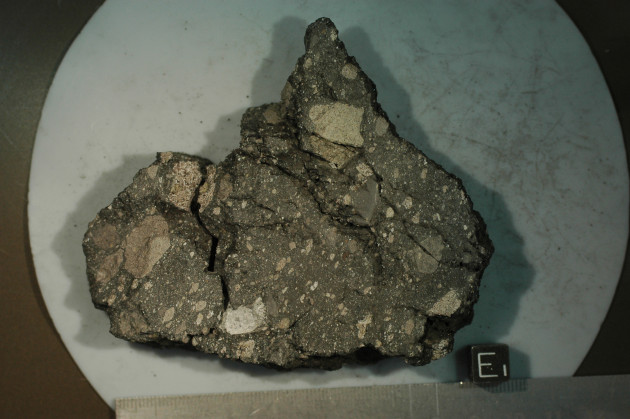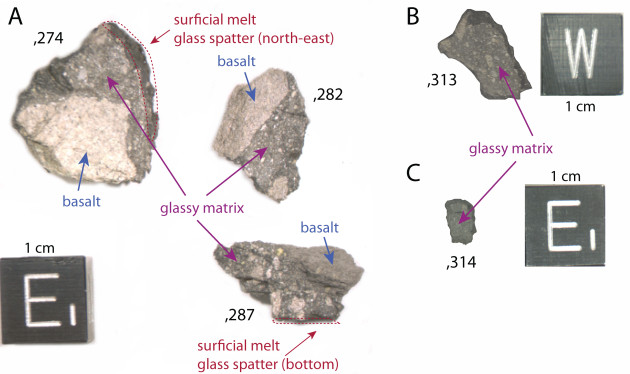
by Laura Reynolds Friday, November 17, 2017

Lunar breccia sample 15498, collected during the Apollo 15 mission, consists of basalt fragments welded together by dark lunar glass that formed during an impact event. The scale cube marked "E" is one centimeter wide. Credit: NASA
Magnetized lunar rocks collected by the Apollo missions indicate the moon had its own magnetic field, generated by motion of liquid metal in its core, until at least 3.2 billion years ago. However, what powered the lunar field and how long it lasted has been unclear. Now, new research reveals that the lunar magnetic field lasted until at least 2.5 billion years ago, and possibly even until 1 billion years ago.
That’s “much longer than previously thought,” says Benjamin Weiss, a planetary scientist at MIT and a co-author of the study published in Science Advances. However, “something happened dramatically between 3.5 billion and 3 billion years ago, when [the lunar magnetic field] got really weak,” Weiss says.
Prior research on the lunar dynamo — the mechanism that generated the moon’s magnetic field — has focused on records of magnetism preserved in lunar rocks older than 3 billion years. Volcanic rocks contain magnetic mineral grains that behave like tiny, floating compasses while the rock is hot. These compasses align with whatever magnetic field is present and freeze in place when the rock cools and hardens. Scientists can measure the residual, or remanent, magnetism in lunar volcanic rocks to infer the intensity of past magnetism on the moon’s surface.

Chips from lunar breccia sample 15498 were analyzed in the new study to study the moon's paleomagnetism. Credit: Tikoo et al., Science Advances, August 2017
Because volcanism on the moon’s surface, and therefore the creation of new rock, ceased about 3 billion years ago, it has been difficult to find younger records of lunar magnetism, Weiss says. In the new study, he and his colleagues measured the remanent magnetic field preserved in a sample of lunar glass retrieved by the Apollo 15 mission in 1971. The glass formed during a meteoroid impact 1 billion to 2.5 billion years ago that melted and welded together fragments of older rock, preserving a record of the magnetic field at the time of impact. The researchers found that the field strength at the time of impact was about 5 microteslas, roughly a tenth of Earth’s current field strength. In contrast, field strengths inferred from lunar samples older than 3 billion years are between 20 and 110 microteslas.
The implication of the finding is that the moon’s magnetic field lasted “at least 2 billion years, maybe even 3 billion years, which requires a long-lived energy source,” Weiss says. One process that could generate a long-lasting dynamo is mantle precession: Studies have suggested that “the solid outer part of the moon wobbled with respect to the inner liquid part,” causing the outer core to be stirred like liquid in a blender, Weiss says.
A second possible explanation is compositional convection: As molten material in the outer core cools, parts of it crystalize and solidify onto the solid inner core, which drives motion in the remaining liquid. This process is thought to be partially responsible for Earth’s magnetic field, and models have shown it could produce field strengths similar to those inferred from the young lunar sample measured in this study.
“Theoretical studies have shown that this compositional convection effect is plausible” for dynamo generation, says Ian Garrick-Bethell, a planetary scientist at the University of California, Santa Cruz, who was not involved in the new study. But prior to this research, “there hadn’t been any measurements to show that there was a field on the surface [of the moon] due to this mechanism.”
Neither mechanism alone seems to explain both the relatively high strength of the early lunar magnetic field inferred in previous studies, as well as the extended, weaker magnetic field inferred in this study. Weiss says that in the early moon, the liquid in the core “was so hot that it was rising and cooling, from the base of the core to the top of the core … like a lava lamp.” But it’s thought that a dynamo generated by heat-driven convection would not have lasted longer than a few hundred million years after the moon’s formation roughly 4.5 billion years ago. Therefore, he says, while the strong, early field might have been generated by heat- and/or precession-driven convection, the later, weaker field might have been sustained by compositional convection.
However, Weiss says, it is also possible that a single mechanism — either mantle precession or compositional convection — could indeed have powered the moon’s magnetic field the whole time, and that the drop in strength 3 billion years ago resulted from the field transitioning from a dipolar to a multipolar state. In a dipolar magnetic field, like Earth’s field today, magnetic field lines are parallel to the surface of the planet and each pole is either strongly positive or strongly negative, like a bar magnet. In multipolar magnetic fields, Weiss says, field lines resemble “a bunch of spaghetti” and “the field gets weak and complicated.”
Research on the lunar dynamo contributes to a broader understanding of a very common phenomenon, Garrick-Bethell says. “There’s magnetism everywhere in the universe and everywhere in our solar system,” he says. Mercury, Earth, Jupiter, Saturn, Uranus and Neptune all have dynamos, he notes. “Even the sun has a dynamo … Dynamos are more the rule than the exception.”
There is still much to be learned about dynamo processes, however, especially for small bodies such as asteroids and the moon. “No one has been able to explain how such a little core could make such an enormous field” in the moon’s early history, Weiss says. “And that remains unexplained.” As does, he notes, the age at which the lunar dynamo ultimately went extinct.
Numerical models capable of modeling dynamos driven by mantle precession or core crystallization would help test hypotheses for the evolution and history of the lunar dynamo, Weiss says, as will future magnetic measurements and better age constraints on young lunar rocks.
© 2008-2021. All rights reserved. Any copying, redistribution or retransmission of any of the contents of this service without the expressed written permission of the American Geosciences Institute is expressly prohibited. Click here for all copyright requests.